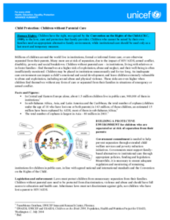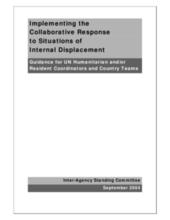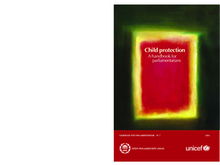Demographic Data
|
Sources: World Bank, UNICEF, UNDP HDR 2015, DHS 2014 |
Displaying 13981 - 13990 of 14391
A brief fact sheet on the multilevel support needs of children without parental care. Includes a brief section on statistical data and examples of UNICEF action in several countries around the world.
This research study provides statistical information on institutional care of children under the age of 12 in Brazil. Interviews with institutions and children are conducted, and reasons for separation from family, length of time in care, status of family relationship, religious orientation and financial support of the institutions are highlighted.
A document with guidelines and the framework for a comprehensive and accurate response to the problem of displaced persons.
A paper that makes recommendations (based on field work) to the UN, NGOs and governments for a more effective international system to care for internally displaced persons.
This report contains an overview of alternative care in Europe, the effects of institutions on children, statistical information and the different approaches of child protection systems within Europe. It includes reforming institutional care, foster care, post-care support, and the role of the social worker.
A comprehensive framework to ensure that the rights and needs of separated children are effectively addressed. Guidelines aim to promote and support preparedness, coordination and good practice based on lessons learned. Addresses all aspects of an emergency from preventing separations, to family tracing and reunification, through to long-term solutions.
This paper outlines a program (SIMBA) established to work with local AIDS Service Organizations (ASOs) in Zimbabwe to promote economic development in HIV/AIDS affected communities. Efforts to promote capacitiy building of organizations, self-managed and savings-based microfinance services, and basic business management training are described.
A document consisting of the policies and practices that will guarantee the promotion and protection of the rights of separated children in Europe. The Statement works as a framework for action and advocacy and makes references to relevant international and regional laws as well as policy and guidelines regarding progression of human rights protection and issues particularly affecting separated children.
A handbook that includes examples of the many ways in which Parliaments and their members around the world have responded to the challenges of child protection through laws, policies, advocacy and other means. It also describes how Parliaments and their members can gain a clearer understanding of what their contribution can be, and equips them with the knowledge and tools they require to make that contribution.
A review of interventions for orphaned and vulnerable children that focuses on community-supported, home-based care examples. Highlights several models and programs, such as the COPE approach and Village AIDS Committees. Advocates the need for more research-based interventions and evaluation.










